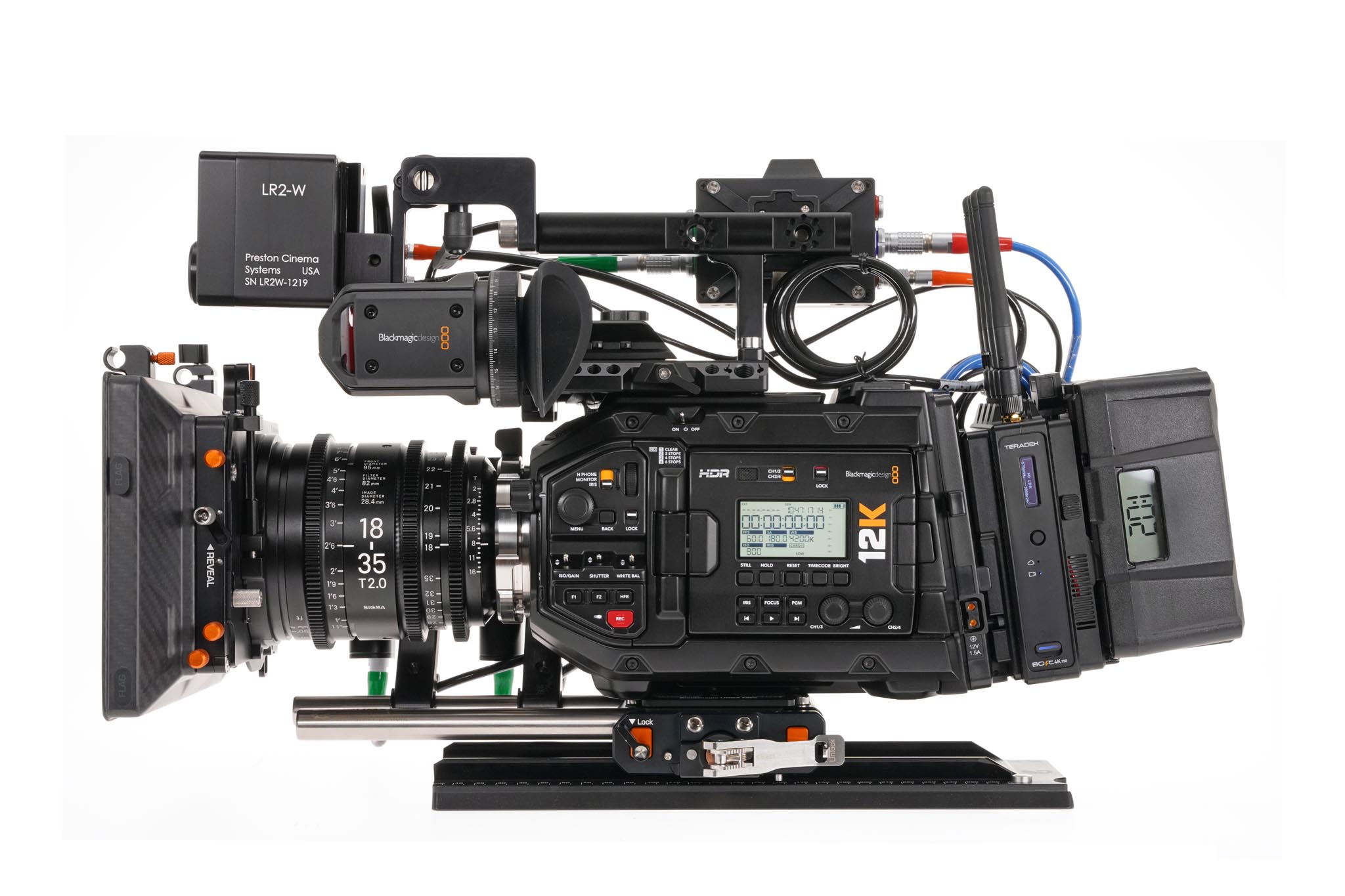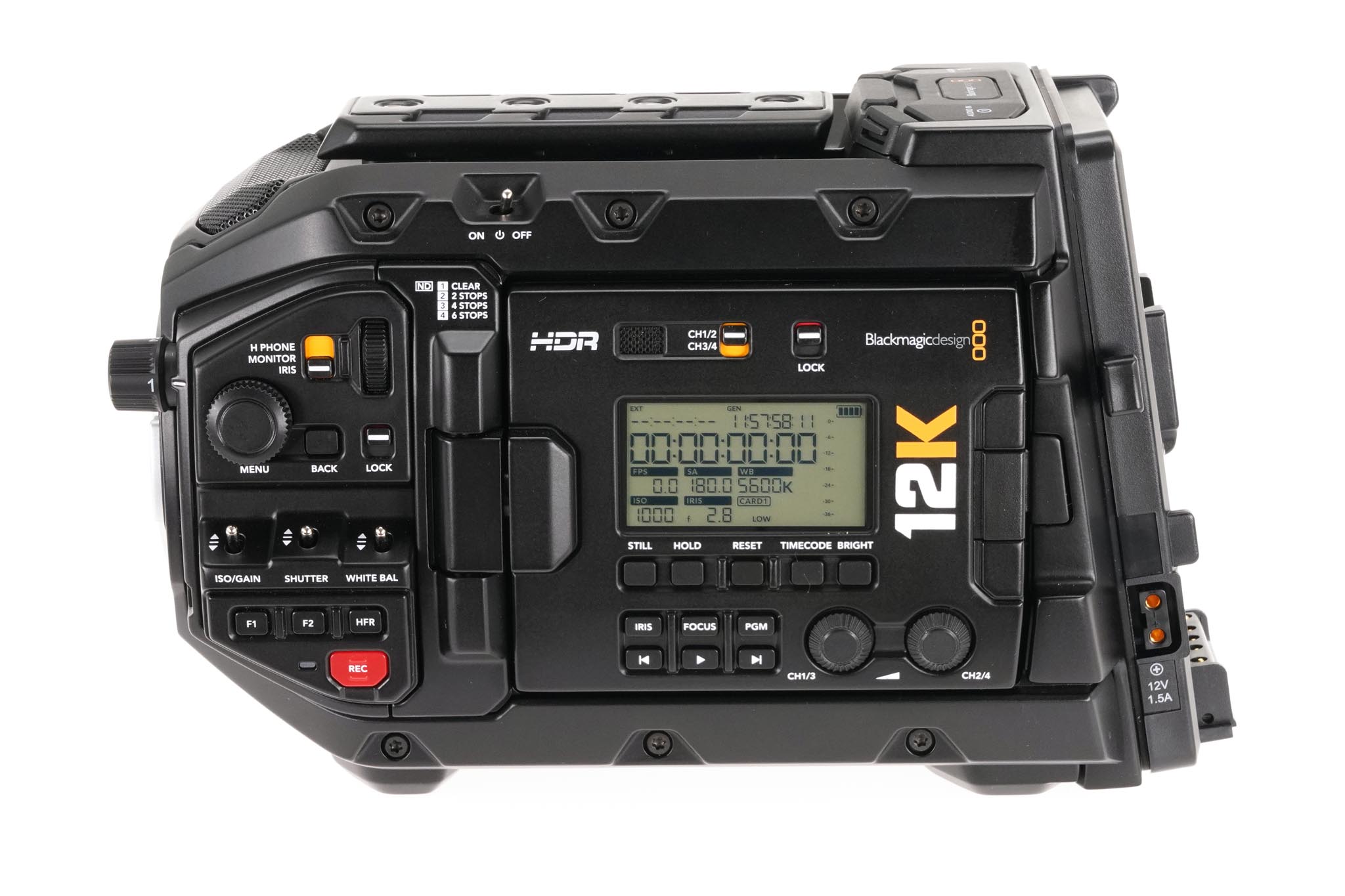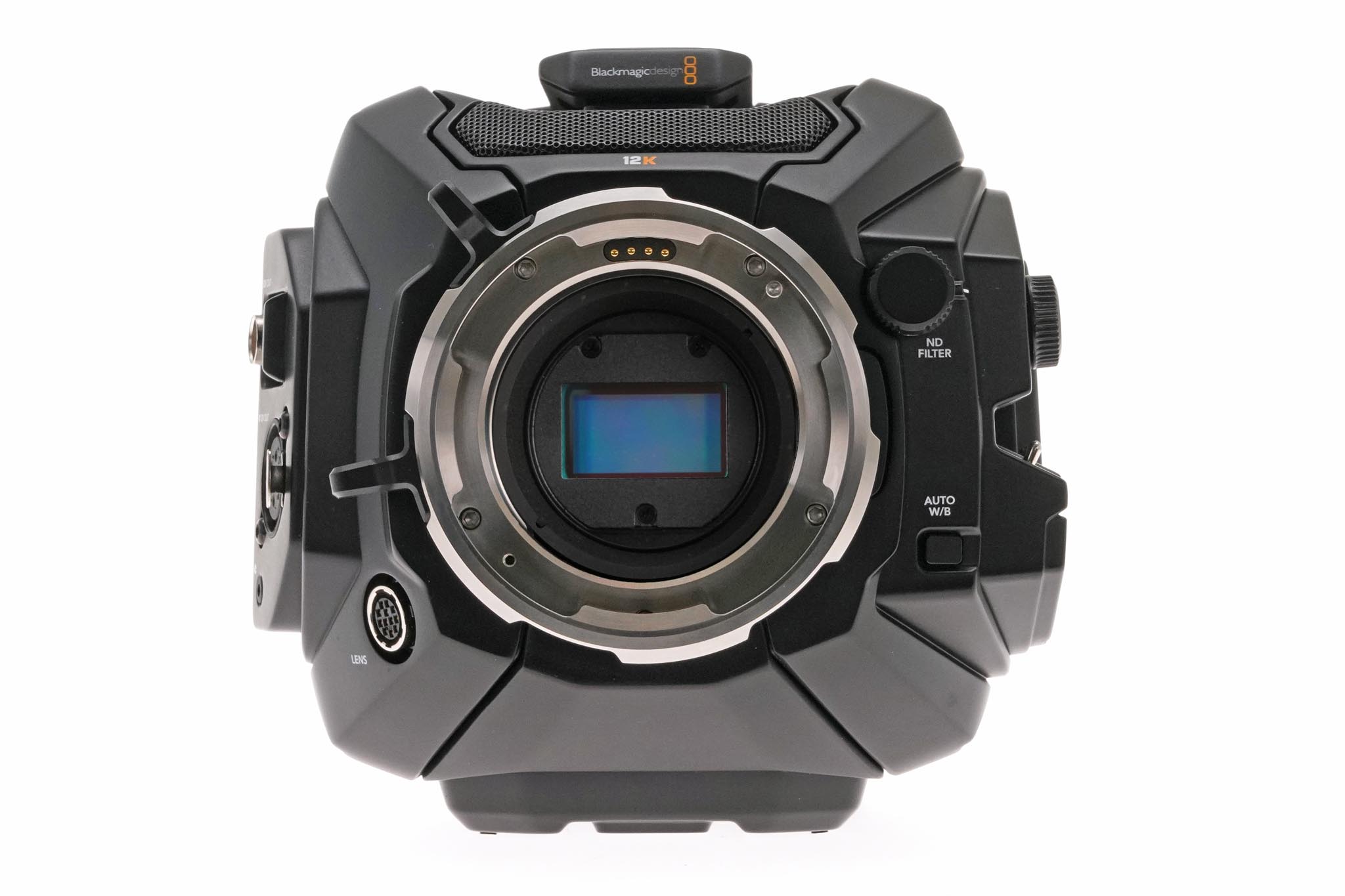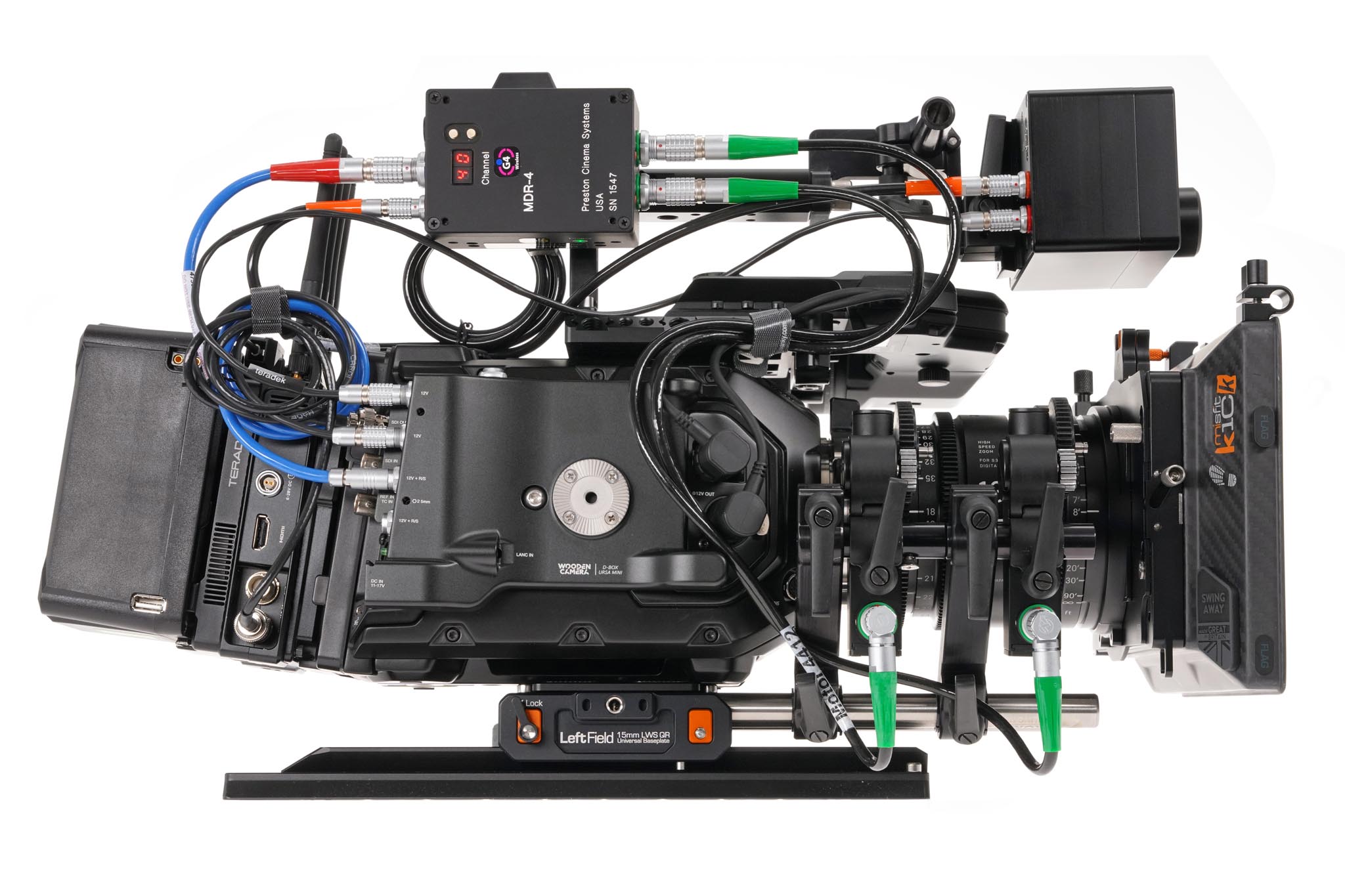
URSA 12K Chockers. “Chockers” is Australian for “fully festooned.” Because the URSA 12K camera package will be shooting major shows, you will see many of them in full chockers mode, like this. And yes, the chockers things in this photo cost extra: Bright Tangerine accessories, Preston LR2W with MDR-4 and motors, Teradek BOLT 4K, and SIGMA 18-35 T2 Zoom.
This is irresistible. The Blackmagic URSA Mini Pro 12K can now be had for US$5,995. That is a $4,000 drop from its original $9,999.
Blackmagic says, “This price reduction has been made possible by efficiencies in manufacturing combined with an improved supply of 12K sensors. With this new low price for Blackmagic URSA Mini Pro 12K, a much wider range of customers will have access to feature film production.”
That has been a guiding business model of the Melbourne, Australia company—make great products eminently affordable so lots more people can buy them, thus enabling the lower cost.
I heard some skeptics mutter that price drops sometimes portend progression. But this thing is now so affordable, it doesn’t matter.
In case you don’t have time to download the complete FDTimes URSA 12K Special Report, here’s a Cliff’s Notes review with some updates:
Blackmagic URSA Mini Pro 12K is available now from Blackmagic Design resellers worldwide for US$5,995.
URSA 12K is a serious camera that shoots stellar Super35 images at an astonishing 79.6 Megapixels per frame (12,288 x 6480) up to 75 fps in 2.39:1 (2.4:1), among many other aspect ratios, frame rates and resolutions.
Blackmagic RAW (BRAW) 12-bit files can be nimbly edited and finished even on a laptop. DaVinci Resolve 17.3, also announced today, works up to 3 times faster on Macs with the M1 chip. You can play, edit and grade 4K and 8K projects faster, even work on a laptop.
URSA 12K weighs about 5.6 lb and is slightly larger than a large can of Fosters.
Three internal ND filters and one clear filter with IR compensation can be summoned up with the twist of the ND dial: Clear, 2, 4 or 6 stops.
The camera comes with a PL mount. You can swap it quickly and easily for an optional EF or F mount. The EF mount offers autofocus and auto/user controlled exposure. The PL mount provides /i metadata embedded recording.
The main display on the camera left door shows timecode, shutter, lens settings, battery, recording status and audio levels. The display is backlit and visible in dimly lit studios or direct sunlight. Open the display door to reveal a 4-inch LCD touchscreen monitor and dual CFast 2.0 and UHS-II SD media slots. If you’d like more recording time, connect a SATA or NVMe drive to the camera’s rear USB-C 3.1 Gen 2 port.
A BNC connector at the front camera right side provides HD-SDI (up to 3G). This is where you’ll plug in Blackmagic’s excellent 1920 x 1080 OLED URSA Viewfinder. It’s an essential optional extra and the $1495 price is a bargain compared to one out-of-focus shot. The camera’s rear BNC provides menu-selectable 4K SDI or HD-SDI (up to 12G) output.
So how does URSA Mini Pro 12K confound current credo with smaller pixels and more of them and great color science and gorgeous images?
Blackmagic’s 12K sensor does not have a typical RGB Bayer pattern color filter array. Instead, it’s an equal arrangement of RGBW—red, green, blue and clear (unfiltered-white). The W (clear) photosites add additional values of brightness and sensitivity to the RGB color-filtered photosites to get extended dynamic range and lower noise. You can find the patent online.
OK, I hear the chants of “Why do we need 12K?” Here’s why.
The 12K sensor scales from 12K to 8K or 4K without cropping or binning. Most of us who have shot commercials never encountered an art director lacking an irresistible urge to repo (reposition) and blow up (enlarge) things in post. Often, the only restriction was resolution: blow up too far and it looks like noisy gold balls. If you’re shooting in 12K and finishing for 4K, that art director will weep with joy at the almost limitless possibilities to mess with your masterpiece and zoom in on the product’s logo. Even better, you can grab individual frames in DaVinci Resolve (View>Stills>Grab Still) and then Export (Right Click on the thumbnail>Export with LUT).
Bob Caniglia, Blackmagic Design Director of Sales Operations, North America, explained the efficiencies of 12K: “On its own, 12K is obviously a huge number. In order to shoot 12K or 8K, you truly need to be able to use it. One of the challenges set out from the start of this project was to be able to have hardware over-sampling to make 8K files or 4K files from the 12K files, but to be able to do it without requiring a supercomputer.
“It was a combination of our managing the color science, having Blackmagic RAW, developing the sensor and having DaVinci Resolve Studio (included with the camera) on the back end to deal with the files. For example, this camera lets you shoot 12K plates for VFX. For 8K or 4K, the camera does in-camera hardware scaling. And, if you’re shooting vertical video, you get a 6K vertical format.”
The URSA 12K records in constant quality or constant bit rate.
Constant bit rates are 5:1, 8:1, 12:1 or 18:1. So, 12K 5:1 at 24 fps is close to 600 MB/s. 18:1 in 12K at 24 fps gets it down to 160 MB/s.
“Constant quality choices are Q0, Q1, Q3 and Q5. Image quality stays the same but the amount of compression varies depending what you are filming.
For example, if the scene involves an actor standing still in front of a white cyc, the image data can be compressed more because there is very little detail in the background and little movement. However, if you are filming an actor running in the street, the camera would demand less compression to get the same quality because there’s a lot more fine detail and motion. In Q0, the highest quality, data rates are from 289 to 1200 MB/s. The compression ratio ranges from about 5:1 to 12:1, depending on the scene. Q5 is constant quality with the most compression—from 96 to 413 MB/s.
BLACKMAGIC URSA Mini Pro 12K Summary
- 12,288 x 6480 12K Super35 sensor.
- 14 stops of dynamic range and native 800 ISO.
- Up to 60 fps in 12K; 120 fps in 8K DCI; 240 fps in 4K S16.
- Dual CFast 2.0 slots for recording to 900 MB/s.
- PL mount included; EF and F mounts available.
- USB-C 3.1 Gen 2 for recording to external disks.
- Includes DaVinci Resolve Studio. Edits and grade Blackmagic RAW 12K in real time.
- Size: 5.92” W x 9.2” L x 5.78” H. Weight: 5.62 lb.
- Blackmagic URSA Mini Pro 12K: US $5,995.
- Blackmagic URSA Viewfinder (essential): US $1,495.
- V or Gold Mount Battery Plate: $95.
- Shoulder Kit w/ top handle for EVF (almost essential): $395.
- Blackmagic URSA Mini Hand Grip (helpful): $199.
- Comes with PL Pro PL Mount with /i contacts.
- EF Mount with lens data and power pogo pins: $175.
- Pro F Mount w/ back focus adjustment, no lens contacts: $375.
- Recorder attaches to rear for NVMe or SSD media: $395.











